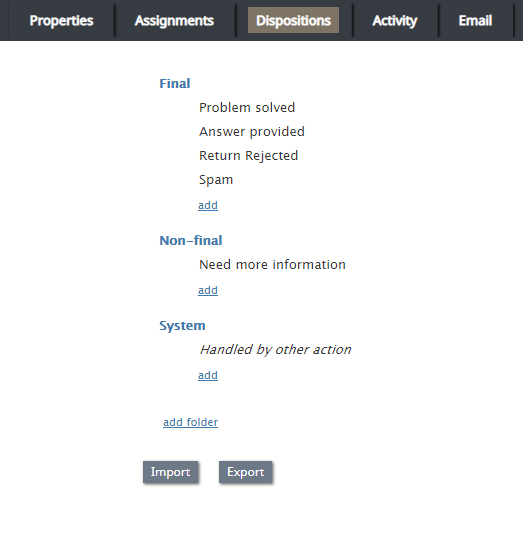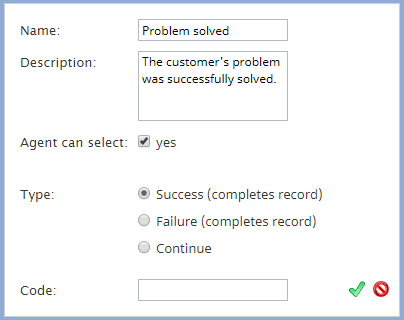Dispositions Tab
Dispositions are used to specify the result of an interaction attempt. For example, a disposition may indicate that the requested service was provided, or it might suggest a specific reason why it was not provided. Dispositions are stored in the interaction records and campaign results. They can be used in custom queries and reports for evaluation of service efficiency.
Note: The Dispositions tab is displayed only if the Use dispositions option is selected on the Properties tab.
In outbound campaigns, dispositions are also used to determine subsequent processing of calling records depending on the outcome of each call attempt. See section Outbound - Dial Rules for more information. In outbound campaigns, some of the dispositions can be applied to entire calling records and some others to individual call attempts.
For outbound campaigns of preview type, dispositions are also usually defined for preview records. In such campaigns, agents receive calling records from the system and preview them before making the corresponding outbound calls. During the preview, they may decide to discard some records without dialing. Dispositions in this case can indicate the reason (e.g., incomplete data).
For blended services, inbound dispositions are processed within the context of the campaign that is part of the same service. For example, if a customer misses your campaign call and then calls back using the campaign's caller ID and buys the product you have been offering within the campaign, the disposition of that inbound call should normally prevent subsequent attempts to call this customer within the same campaign. Therefore, for blended services it is important that the
- Inbound and outbound dispositions correlate (i.e., the former normally should be a subset of the latter)
- Outbound portion of your blended campaign is kept enabled at all times--even during the periods without any outbound activity
If the reason for a failed interaction attempt can be recognized automatically, the corresponding disposition can be provided by the system. Dispositions that are specified manually will be displayed by the Agent Desktop and can be selected by the agent at any time during interaction handling, including the after-call work. Dispositions can also be set by a scenario.
Screen Properties
Show dispositions for
This option is displayed only for outbound and blended voice services. To review and edit dispositions for inbound calls and list records, select inbound. To review and edit dispositions for outbound calls and list records, select outbound. To review and edit dispositions for preview records, select preview record.
List of dispositions
This option lists the dispositions for this service. For the services that comprise different types of interactions (inbound, outbound, preview records), the list will display only the dispositions corresponding to the interaction type selected via the Show dispositions for option.
For each interaction type, the system provides a pre-defined set of dispositions. You can edit such predefined dispositions, remove some of them, define new ones, and arrange them in your own folders. The purpose of each predefined disposition is explained in the Description field, which you will see when you click a disposition once.
Even though the system provides a predefined set of dispositions for each new service, you can still control whether these dispositions will or will not be made available to agents for selection when they handle interactions associated with the given service. Furthermore, you can control whether the use of dispositions is mandatory or optional. For more information, see the description of settings Use dispositions and Require dispositions in the Services and Campaigns - Properties tab.
Dispositions properties editor
To create a disposition in an existing folder, click add in the desired folder; this will open the dispositions properties editor, allowing you to configure the following. To edit a disposition, hover over the disposition and click the edit icon. To delete a disposition, hover over the disposition and click the delete
icon.
Name
This field is where you specify the disposition’s name. Note that this field is mandatory and must be unique within the given interaction type within the service.
Description
This optional field allows you to provide a free-text description of the disposition.
Agent can select
By default, dispositions that you define will be made available to agents for selection during interaction handling. If you do not want the given disposition to be shown to agents (e.g., you intend to use this disposition in scenarios only), unselect the Agent can select checkbox. Note that dispositions unavailable to agents appear in the disposition list in italic.
Show in toolbar in team queue
This option, available for email services only, allows you to configure an icon for the disposition, which is displayed as a button in the team queue and personal queue toolbar when an email's corresponding checkbox is selected. This button allows agents to apply a disposition to an email without opening it, thus removing it from the queue. Note that when configuring this option, you must select a corresponding toolbar icon.
Buttons mapped to either the Final disposition or Spam disposition apply the Resolved status to all selected emails. Buttons mapped to the Nonfinal disposition do not apply a different status to the selected emails (i.e., all selected emails will retain the New status). On this note, it is recommended that buttons are mapped to dispositions of the Final type to prevent important emails from accidentally being removed from the queue.
Toolbar icon
When the Show in toolbar in team queue option is selected, the toolbar icon option appears; this setting lets you map an icon to a disposition that will be displayed as a button in Agent Desktop's team queue and personal queue. To map the icon to the disposition, select the search icon or click icon search to access the drop-down list of toolbar icons.
Type
Type is a disposition category that executes specific actions when applied to an interaction; available types vary per service. The following is a list of all disposition types. Note: Dispositions considered final (i.e., ones that complete records or cases) are editable by those with the privilege Can update final dispositions only.
Success (completes record or case)
Success is for dispositions indicating successful interaction processing (e.g., the customer has accepted the offer) or closure of a case.
Final (completes record or case)
Final is for dispositions indicating successful interaction processing (e.g., the customer has accepted the offer) or closure of a case; this type is available for email services only.
Failure (completes record)
Failure is for dispositions indicating unsuccessful interaction processing without subsequent attempts (e.g., the customer has rejected the offer); this type is available for voice services only.
Do not Call (completes record)
Do not Call is for dispositions indicating that the customer has requested not to be contacted again for the given reason; this type is available for voice services only.
Continue
Continue is for dispositions indicating unsuccessful interaction processing with possible subsequent attempts (e.g., the customer has asked to be called again at another time) or expected continued processing of a case; by default, any new disposition of this type is associated with action Reschedule (24h); for more information, see section Outbound - Dial Rules.
Nonfinal
For dispositions indicating unsuccessful interaction processing with possible subsequent attempts (e.g., the customer has requested to be contacted at another time) or expected continued processing of a case; this type is available for email services only.
Spam
For dispositions indicating an immediate closure of an email case because the incoming message was spam
For services that comprise different types of interactions (inbound, outbound, preview records), you can also specify if the disposition you define for one interaction type shall be available for interactions of other types within the same service. Select such desired additional interaction types via the Scope option.
Code
If, in addition to the disposition name, you would like to use a short alphanumeric code (string), specify it in the Code field. Disposition codes are optional, and when defined, will appear in campaign results along with disposition names. Codes can also be used instead of disposition names when setting dispositions in scenarios.
There are no predefined disposition codes because you can assign any string to be a disposition code. A disposition code can contain up to nine characters; any characters are allowed. Note that the system does not check uniqueness of disposition codes.
Add folder
The add folder option allows you to create a new folder for dispositions. To add a new folder, click add folder, specify the folder name, then add the desired dispositions.
Import
The Import option imports dispositions and allows you to define dispositions externally and import them in the .CSV format. For each disposition, the following fields must be defined in the specified order:
- Name
- Folder name (disposition category)
- Description
- Code
- Agent can select (true, false)
- Type (SUCCESS, FAILURE, CONTINUE, DO_NOT_CALL)
- Is inbound (true, false)
- Is outbound (true, false)
- Is preview (true, false)
- System type (if defined, the disposition will be followed by the same actions that are defined for the corresponding default dispositions in the Connection Problem and System folders)
- Possible values include the following: empty string, DROPPED, BUSY, NO_ANSWER, FAX_MODEM, ANSWERING_MACHINE, SILENCE, INVALID_NUMBER, OTHER_CONNECTION_ISSUE, ABANDONED, CONGESTION_REMOTE, NO_AGENT, NO_DISPOSITION, SKIPPED, SYSTEM_FAILURE, AGENT_FAILURE, FINALIZED_BY_DIAL_RULE, MAX_ATTEMPTS_REACHED, DISPOSITION_NOT_FOUND, PHONE_NETWORK_UNAVAILABLE, RECORD_EXPIRED, CALL_FAILED, FAST_BUSY, ANNOUNCEMENT, NETWORK_ANNOUNCEMENT
- Service type (since many dispositions are service/media-type-specific this field must be defined to make sure that the dispositions are not imported into a type of service they are not intended for)
- Possible values include the following: INBOUND, OUTBOUND, BLENDED, CHAT, EMAIL
Each value must be enclosed in the quotation marks. Optional parameters must be set to an empty string when not defined.
An easy way to create an import file is to export an existing list of dispositions (see Export below) and modify it as may be necessary.
Export
This option exports dispositions in .CSV format. The exported file can be used as a template when defining dispositions externally and importing them into the system. For specification of the fields, see the description of the Import function.


